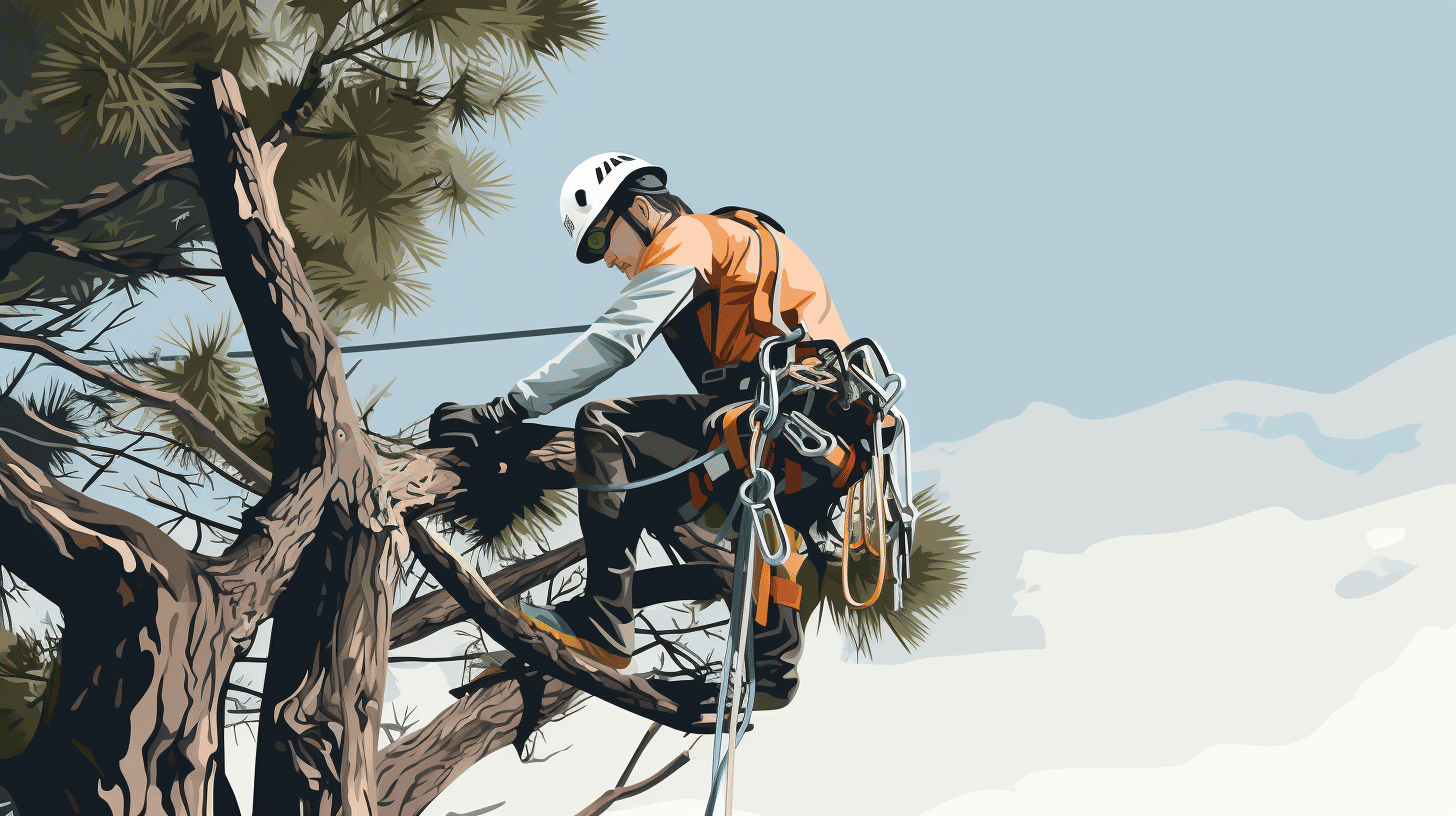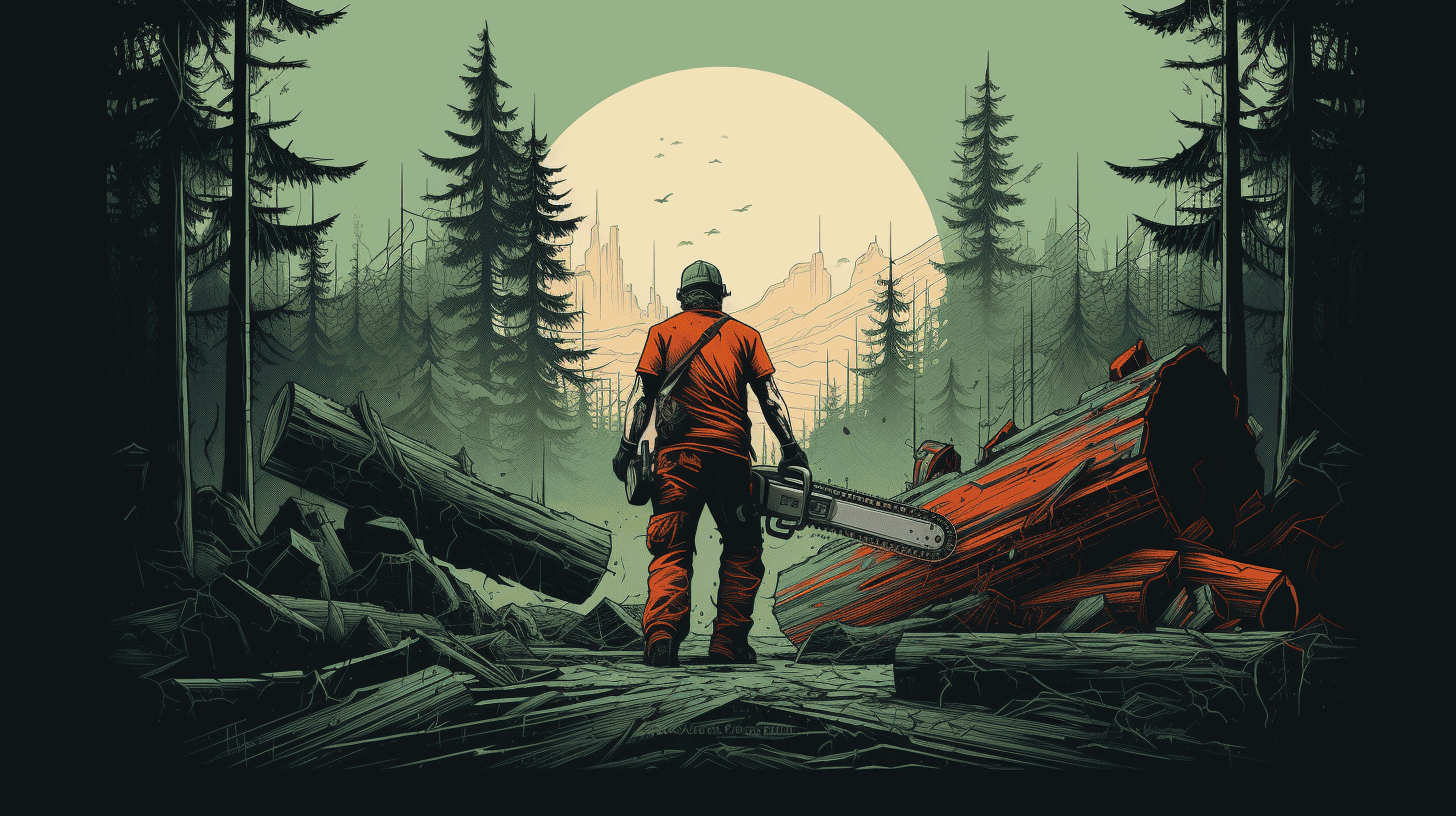Statistics on Arborist Injuries and Fatalities
Statistics on Arborist Injuries and Fatalities
Arboriculture, the science and art of managing trees, may sound like a calm and peaceful profession. Still, it holds surprisingly high rates of injuries and fatalities. Analyzing the reports of the US Bureau of Labor Statistics, one can glean alarming insights into the life-threatening risks associated with this field.
Diving deeper into the risks, we find that arborists have at least a staggering 15 times the fatality rate compared to all other industries. This data certainly highlights the life-threatening jeopardy these brave workers face every day. While it's a sobering fact, it's crucial to remember that these individuals play a crucial role in our environment's maintenance and preservation.
Moreover, not all incidents result in fatalities; however, the occurrence rate of nonfatal injuries is also considerable in this area. The nonfatal rate of injury for tree workers is three times the average of all sectors. Whether it's a slight mishap or a severe accident, the safety of arborists is always at stake. The reason behind such a high injury rate usually relates to arboriculture's physically demanding nature and the requirement to work with heavy machinery.
Crucially, we must also consider falls from height, a common hazard in this line of work. According to the data, fatal work-related falls to a lower level increased by nearly 26% between 2011 and 2016. This climb in the statistics is concerning and demands the implementation of robust safety measures to prevent such incidents.
Equally alarming is the record of chainsaw injuries and worker deaths amongst arborists in North America, with an estimated 23,000 chainsaw injuries and 80 worker deaths each year. These figures underline the danger that even the most common tools in arboriculture can pose when used without adequate safety measures.
Lastly, the US Bureau of Labor Statistics reports an average of 200 tree-related fatal injuries every year in the United States. These numbers are yet another glaring reminder of how hazardous an Arborist's job can be.
While these statistics on arborist injuries and fatalities are indeed shocking, they are vital. The raw data serves as a call to action for individuals, organizations, and authorities involved in the industry. Without a doubt, the field of arboriculture needs to implement more vigorous safety training, strict regulatory measures, and continuous efforts to reduce these numbers and safeguard our vital workforce.
Importance of Personal Protective Equipment (PPE) for Arborists
Working at heights while battling the weather and overcoming nature's unpredictabilities is no ordinary feat. This everyday reality is a breed apart for arborists and tree care professionals, making it deeply imperative to take safety measures seriously. Among these, Personal Protective Equipment (PPE) holds a centerpiece of the discussion.
Helmets, Gloves, and Eye Protection
Helmets! Yes, they are the crucial protective headgear that safeguards arborists against the risk of objects falling from heights. As arborists are frequently in the line of potentially dangerous tree branches and debris, a sturdy helmet is an unquestionable necessity. In addition to this, gloves and eye protection are equally important to shield your hands from potential cuts and blisters and your eyes from dust, debris, or flying bits.
- Consider our helmets as an essential shield guarding against falling debris.
- Our gloves and eye protection contribute significantly to overall safety.
No compromises should be made when it's about choosing the right protective gear. We recommend you to explore the Best Quality Products for Arborists for uncompromised safety!
Cut-Resistant Clothing
As an arborist, you regularly work with sharp tools and machinery, which makes you susceptible to potential cuts and lacerations. This crucial fact accentuates the importance of cut-resistant clothing. Featuring specifically designed gloves and leg protectors, they not only protect you from potential injuries but also offer extra peace of mind during your rigorous routines.
Fall Protection Gear
Think about the typical working environment of an arborist. Precarious perches on tall trees, a windy day, or even a misstep could result in a dangerous fall. That's where fall protection gear comes in. Essential for the safety of arborists, this gear is also crucial for the well-being of those working in close proximity to arborists. Harnesses, ropes, lanyards, and carabiners are all integral components of an arborist's fall protection arsenal.
Proper Footwear
Last but not least, proper footwear. The right shoes not only provide comfort during long working hours but can also significantly impact an arborist's stability while working at heights. Properly designed, high-traction forestry boots can effectively prevent slips and falls, ensuring you carry out your duties safely and competently.
To sum up, the significance of Personal Protective Equipment for arborists can't be overstated. Each piece of PPE, from helmets to high-traction boots, plays a crucial role in ensuring the safety of arborists. Safety should always be the number one priority, and with the right PPE, arborists can continue to do their jobs securely, confidently, and effectively.
The Role of Ropes and Regular Equipment Inspections
Within the dynamic world of tree care and arborist work, few things take precedent over safety equipment. Paramount among these resources are the lifelines themselves—the ropes. Truth to be told, ropes are a critical aspect of arborist safety. When soaring high above the ground amidst towering trunks and sprawling branches, the humble rope becomes a lifeline, a connection between the arborist and the terra firma beneath them.
Notably, the risks associated with an accidental cutting or failure of ropes are severe, sometimes even fatal. Like a hidden guardian, the rope acts as a silent protector. Hence, the quality and integrity of ropes become crucial points of consideration for arborists worldwide.
However, the role of ropes extends beyond just 'safety'. For it's inextricably linked with efficiency in tree care, making it a functional pillar of the entire operation. Herein lies the ultimate challenge—the delicate balance of adhering to safety protocols while still maintaining operational efficiency.
To achieve this seemingly elusive harmony between safety and efficiency, a well-defined regimen of regular equipment inspections comes into play:
- Prevention is Better than Cure—like with any equipment used in high-risk environments, the importance of regular inspections cannot be overemphasized. Identifying signs of wear and tear can prevent accidents from occurring in the first place.
- Improved Efficiency—Inspections are not merely a safety protocol; they also contribute to work efficiency. Regularly serviced and maintained gear performs better and can drastically reduce the time required for tree work.
- Longer Equipment Life—In a more practical sense, regular inspections lead to longer equipment life, saving arborists both time and money in the long run. Neglected gear tends to break down faster and is more expensive to replace.
Just as one wouldn't go on a hike with worn-out boots, an arborist shouldn't be suspended in air with a frayed rope and imperfect gear. Just like an accomplished chef meticulously sharpens their knives, so too must an arborist be devoted to the routine maintenance and inspection of their ropes and gear. It's not just a protocol; it's a commitment to their own safety and the quality of their work.
While ups and downs are part of an arborist’s life (literally), the last thing one wants is an unexpected plunge. Let the rigging and climbing ropes be the trusted safety net that guards against the fall. In essence, regular maintenance and inspections are powerful practices in an arborist’s arsenal—remarkably simple yet profoundly impactful. For, when we acknowledge and respect the gravity of the task we undertake, we pave the path for a safer, more efficient, and more enjoyable work experience.
So, remember: inspect, maintain, and be safe. After all, when you're hanging in the balance, the rope is more than just a tool; it is truly a lifeline.
Importance of Insurance in Arborist Work
In contemporary society, conducting business without insurance is not just risky—it's almost unthinkable. This rings particularly true for arborists, who often face dangerous scenarios where mishaps can lead to significant harm. For anyone stepping into the world of arborist work, securing the right insurance is indeed akin to grabbing a safety net, one that prevents free-falls into dire financial straits.
But, why is insurance so crucial for arborists, you may ask? Well, consider this: out in the field, arborists have a myriad of hazards to deal with. These could range from falling off heights and encountering dangerous equipment to potentially hazardous chemicals. Insurance becomes the security blanket that cushions potential damages or losses that may arise.
- Accident Protection: One of the essential benefits of insurance is the protection it offers in case of accidents. No matter how careful arborists are, there's always a risk. Accidental harm to the property, injuries to workers, or even worse, life-threatening accidents, can end up making a hole in your pocket. Comprehensive insurance coverage can shield against these unforeseen circumstances.
- Financial Safety: An adequately insured arborist business can continue its operations even in the wake of financial setbacks caused by accidents or legal liabilities. Insurance can save businesses from bankruptcy, making it a financial life raft in stormy waters.
- Legal Compliance: From a legal standpoint, having insurance is often mandatory. This is particularly relevant for a dangerous profession like arborist work, where insurance cover is usually a legal requirement, and failure to comply can lead to hefty fines.
- Enhanced Reputation: Lastly, an insured business enjoys greater trust and credibility among its clients. The knowledge that any potential damages will be compensated instills confidence in clients, thus fortifying the business's reputation.
"An arborist without insurance is like a climber without a safety rope. It's not a matter of if a fall will occur, but when."
The demanding nature of arborist work underscores the importance of this financial safety measure even further. Although unanticipated troubles like injuries or property damage are out of our control, the financial fallout resulting from these doesn't have to be.
Emphasizing the crucial role of insurance, it's clear that taking adequate insurance is not just an option—it's a necessity for arborists and their businesses. Ignoring or devaluing it could involve significant financial risk and potential damage to the business reputation. Make sure your arborist business is adequately insured to stand tall, just like the trees you care for—strong and upright, no matter the storm.
The Physical and Mental Challenges of Tree Work
Tree work, in all its forms, is acknowledged as one of the most physically strenuous and mentally challenging jobs. Tree work professionals represent an elite group of workers who daily face adversity in the shape of towering heights, powerful machines, unpredictable elements, and the sheer force of nature itself. It's no idle statement that their foremost concern, especially given the testing physical and mental challenges they encounter, must be to focus on safety.
For starters, the physical challenges that tree work entails are nothing to be taken lightly. Often engaged in lifting heavy limbs, employing sharp tools, and scaling great heights, tree surgeons are required to be in peak physical condition. Here are a few of the physical struggles that tree work professionals encounter in their daily routine:
- Heavy Lifting: One of the most common physical stressors is the frequent heavy lifting involved in tree work. This can include everything from massive logs to hefty equipment.
- Height: Tree workers often must climb dizzying heights - a challenging feat in itself, even without the added physical burden of heavy tools and gear.
- Tools and Equipment: The use of power tools such as chainsaws and chippers require not only physical strength but also fine motor control to operate safely and effectively.
- Weather Conditions: Tree work is an all-weather profession. Workers often must endure extreme temperatures, rain, wind, and even snow.
But physical effort is only half the battle. Tree work also involves a high degree of mental fortitude. The mental pressures that tree workers face can be summarized into a few key points:
- Safety Consciousness: The risk of injury in tree work is considerably higher than in many professions. Constant vigilance and a keen awareness of safety protocols are crucial mental skills in this line of work.
- Decision Making: Tree workers often need to make fast decisions during precarious situations, which requires clear, quick-thinking capabilities.
- Stress Management: Handling the daily physical and environmental challenges require tree workers to efficiently manage stress under tense situations.
There's a renowned statement that encapsulates the essence of tree work, stating, "Being a tree worker is not a job; it's a lifestyle." This sums up the level of dedication and passion required to face the daily physical and mental hurdles of this challenging profession.
Despite the substantial challenges, tree work is richly rewarding for those who respect its rigors and embrace its beauty. It offers workers a strong sense of accomplishment, a chance to commune with nature, and an opportunity for continuous learning. The physical and mental challenges of tree work function as stepping stones towards earning the badge of honor that defines a skilled and devoted tree worker.
Professionals in the field continuously stress the importance of safety, given the inherent risks involved. Through constant vigilance, training, and adherence to safety protocols, tree workers can navigate these physical and mental challenges, ensuring the wellbeing of themselves and those around them. Proudly carrying the flag of honor, these professionals serve as the backbone of an industry that works fearlessly in the face of nature, with svelte skill, strength, and bravery.
Whether it's a need for tree removal, trimming, or even emergency storm response, choosing a tree service that prioritizes safety protocols and boasts a team of seasoned professionals is crucial. Opt for a company that mirrors passion within the tree work industry, respects its intricacies, and is dedicated to the safety of its team and clients. By doing so, you can be confident that your trees are in the best hands possible. Casting respect, courage, and duty as their guiding light, these tree workers face the physical and mental challenges, proving their mettle in this demanding profession.
Conclusion
In the physical and demanding world of tree work, safety should never be compromised. Arborists face incredible challenges every day, and their preparedness and protective gear are their main defences against injury. Remember, prevention is always better than cure. Training, awareness, and top-notch personal protective equipment, like helmets, gloves, cut-resistant clothing, and particularly chainsaw safety pants, form the cornerstone of effective safety protocols.
Last but not least, don't forget the value of regular equipment inspections, the role of ropes, and the importance of insurance for this risky line of work. Be it a rookie or seasoned professional, every arborist deserves excellent protection. Ensure you stay on the safe side with the advanced technology and high-standard materials used in the production of Rain Gear Pro's chainsaw safety pants. Stay safe, stay protected!
Frequently Asked Questions
-
What safety gear should every arborist have?
Every arborist should have the following safety gear: 1. Helmet with face shield or goggles, 2. Chainsaw protective chaps or pants, 3. Steel-toed boots with good traction, 4. Safety gloves, 5. Climbing harness and ropes.
-
Why is safety gear important for arborists?
Safety gear is important for arborists because it provides protection against potential hazards they face while working at heights or with heavy machinery. It reduces the risk of serious injuries and ensures a safe working environment.
-
Are there legal requirements for arborists to wear safety gear?
Yes, there are legal requirements for arborists to wear safety gear. Occupational Safety and Health Administration (OSHA) regulations mandate the use of appropriate personal protective equipment (PPE) for arborists to minimize the risk of injuries and accidents.
-
Can safety gear prevent all accidents and injuries?
While safety gear significantly reduces the risk of accidents and injuries, it cannot prevent all incidents. However, wearing proper safety gear and following safety protocols greatly increases the chances of avoiding severe injuries and minimizing the impact of accidents.
-
How often should safety gear be inspected and replaced?
Safety gear should be inspected before each use to ensure it is in good working condition. Any damaged or worn-out gear should be replaced immediately. Regular maintenance and periodic inspections are crucial to ensure the effectiveness of safety gear.























Leave a comment
This site is protected by hCaptcha and the hCaptcha Privacy Policy and Terms of Service apply.